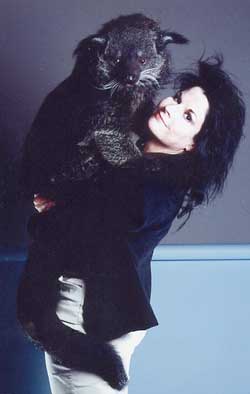
How did your career in animal training begin?
Since the age of 7, I wanted to be an animal trainer. I was always fascinated with animals on TV and in movies and wanted to know how they got the animals to do the things that they did. When I was about 10 years old, I started training my Labrador retriever to take part in dog shows. This was before I knew about clicker training. When I was 16, I snuck a pet rat into my room at the school I was attending and soon discovered how intelligent and easy to train they were.
I started college at the University of Iowa, but transferred to Kirkwood Community College to complete an associate degree in animal husbandry, intending to work in animal training. I did not want to work at a facility where interaction with the animals was discouraged; I wanted to work closely with a variety of animals and train them. Via a series of internships through the school, I quickly discovered what areas of the animal business I did not want to work in.
I moved to Chicago in 1987 where I began to add to my collection of rats and quickly found out that what they could be trained to do was limited only by my imagination. I named my company The Rat Company, and I soon had a variety of tricks that the rats could do. I started performing a trained rat show in night clubs around Chicago. I even had business cards printed up, all in hopes of landing a gig in the movies.
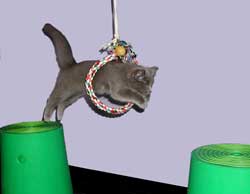
During this period I was also working at a pet store, as the trained rat shows did not really bring in a lot of money. I was working in that store when two customers came in to look at the rats. They told me they wanted a rat for a shot in a film they were shooting. I asked them what they needed the rat to do. They told me they need the rat to scurry across an alley and into a box. I told them that I could get the rat to scurry across the alley, into a box, and answer a small phone if they wanted. I volunteered my services in exchange for credit in the film, and a foot in the door. They were delighted at the thought of a rat trainer helping them with the shot. I was just excited at the chance of one of my rats performing in a movie, and the possibility of a lifelong dream coming true.
Unfortunately with the film business, you don't always get much scheduling notice. I was told on a Friday that I would be needed on Monday. When I asked the pet store for the day off to do the shoot, I was told that if I didn't show up, I would lose my job. Without hesitation I quit my fulltime job for the chance to work for free as an animal trainer for a film. I never regretted that decision.
When and how did you first encounter clicker training (operant conditioning), and how were you motivated to adopt this method for your own training?
I discovered clicker training shortly after moving to Chicago. I was involved in an internship program at Brookfield Zoo. I worked in the children's zoo area. I approached one of the keepers who was in charge of training and expressed my interest in learning how to train some of the animals. She introduced me to the basics of clicker training.
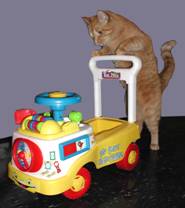
Up until that point, all of my training had been self taught, trial and error. I found that many of my instincts were correct, but through the use of a "bridge" (the clicker), the animals learned much faster. I quickly adopted this training method to my rats, and found that I was able to train more complicated behaviors, in a much shorter time. As I expanded my collection of animals, I applied clicker training to all of them. I discovered that giving an animal the opportunity to learn not only benefited the animal, by preventing boredom, but also strengthened my relationship with that animal.
The clicker became an important communication tool. The animals and I shared a common language, in the form of a clicker. In the year 2001, I discovered Bob and Marion Bailey's Operant Conditioning Workshop (or Chicken Training Camp). I attended a couple of their workshops and learned how to use the clicker more effectively.
Chickens were our working model because they could be given numerous reinforcements in a short amount of time. I learned that timing is crucial when using a clicker. Click too late and you reward the animal for stopping. I never realized I could learn so much from a chicken! This was probably the best and most enlightening set of courses that I have ever taken in the animal field.
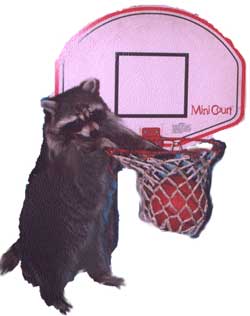
How did you grow from your gratis first film job into a successful business?
On the day of my first film job with the rat, "Chicago's Very Own" WGN TV showed up. They had heard about a rat trainer being on the set, and came to cover the moment. Things snowballed after that when the show was rebroadcast on CNN all over the country.
The trained rat, or Acro-Rat show, began to get me a lot of press. I was flown to Rome to appear on TV there, MTV filmed at my house, and I became a novelty celebrity of sorts: the quirky "Rat Lady." I kept mentioning in each interview that I trained other animals as well, but most of the attention was focused on the rats. I started sending out press releases about my other trained animals, wanting to make sure that people were aware that I was a serious animal trainer and not just some woman with a ton of rats.
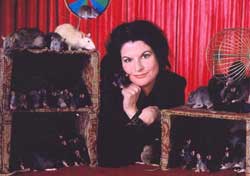
Slowly, I started getting more attention focused on the other creatures and that led to work with different animals. I did a documentary with a well-respected director named Mark Lewis, entitled RAT, which led to another documentary with him called The Natural History of the Chicken. Both were nominated for many awards and each won an Oscar. In 2004, my cat Tuna got a starring role in a short film called Zeke, in which she played a disgruntled male cat, determined to seek revenge on the owner that had had him neutered. During the last few years I have turned my focus to training housecats, as they are much more marketable than rats.
I constantly try to get the word out about new trained animals. I regularly send out postcards about my trained cats to keep directors, marketing executives, and photographers aware of my existence and what my cats can do.
Do you find that your clients are at all interested in your training process, or simply the outcome (producing the desired behavior)?
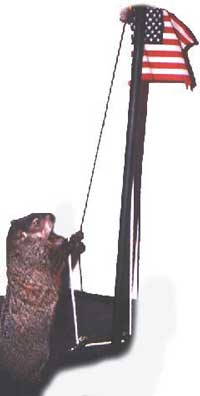
Clients' interest varies. Many do not have a clear idea of what is involved in using an animal for film or photo work. They know that they want a cat or a dog, but they might not know exactly what they want the animal to do. Sometimes you need to really dig the details out of the client and explain that the more you know about what their vision is, the more likely it is that the trainer will be able to guide the animal to complete the actions needed.
It is really important that the animal has been prepped to do the basics, as once an animal knows the basics, you can usually teach other behaviors very quickly. I train all my animals, even though many have never gotten a job call. More than likely, the director will ask for more than what was originally requested, or he may change the shot completely. I have gotten to the point that I can usually look at a script and tell what surprises are going to be thrown my way.
I always bring extra animals to shoots, since animals can suddenly decide they are not in the mood and you want to have an alternative. In one movie I did, I used both a mother and daughter. The mother did a shot which required her to hiss and spit at the camera. The mother had a particularly wicked hiss and was perfect for that shot, but she did not like to do detail work that involved moving from one spot to the other—so her daughter stepped in. I get to know my animals' strengths and weaknesses and work with them. I do not try to change the nature of my animals.
Are there any particularly difficult jobs that stand out for you? How were you able to overcome those challenges? Would this have been possible without clicker training?
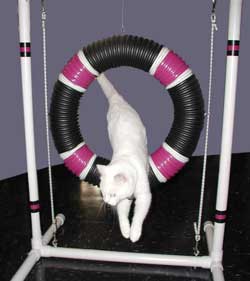
I was prepping for the documentary Natural History of the Chicken. A couple of shots required that a rooster crow on cue. This was a challenge. I couldn't sit around all day waiting for a rooster to crow in order to shape the behavior, so I eventually put a baby monitor in the room with the rooster, and when the rooster began to crow, I would run downstairs and start reinforcing the crow with the clicker. This led to the rooster having ME trained. Whenever he was hungry, he would crow and I would come running. I realized that it was time to put the behavior on a cue. When the rooster started crowing the next time, I ran down and waved a flag as the rooster was crowing. I started only clicking/rewarding the rooster if he crowed while I was waving that flag. Through the use of the clicker, the rooster came to realize quite quickly that he would only be rewarded if he crowed while the flag waved.
I also have a cat that is trained to touch any object. The cat knows the verbal cue "touch," and will randomly start to touch various objects until she hears that click, signaling that she has made the right choice. Through the clicker, she learns new behaviors in one session.
We understand that you live with 20 cats. What's it like to live with this many felines? Do you find that some of your actors simply have more "talent" than others? Are some of your cats just pets, not professionals?
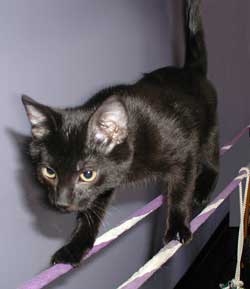
Living with 20 cats is admitting to a life of being single—forever. My kitchen has been converted to a cat training area, my back porch is filled with perches and nooks for the cats to sun themselves, and I carry lint brushes in every purse because no matter what, there will be cat fur on me. Some cats stay in my apartment all the time and others prefer to live on the back porch, but I rotate them so they all get their quality time with me. I have some cats that do tricks but hate shows, so they just stay at home. Probably half my cats are not working cats. They were either rescues or just decided they didn't like performing. Most of the cats work great as kittens, but lose interest or develop a fear of working outside the home in adulthood.
Tuna, my star cat, lives to train and perform. During our training sessions she purrs nonstop. This is the only time that she purrs. The cats that perform at shows are the cats that love to work. They will often just start running through their tricks as a way of playing. I am currently trying to get my trained cat show booked steadily throughout the country at pet shows and expos, so working and traveling are a way of life for them. (To see the Rockats in action, click here.) Cats need to work steadily to have a consistently successful show. Nothing teaches humility like a trained cat show.
To learn more about Samantha's work or to reach her directly, visit www.amazinganimals.biz.



Post new comment